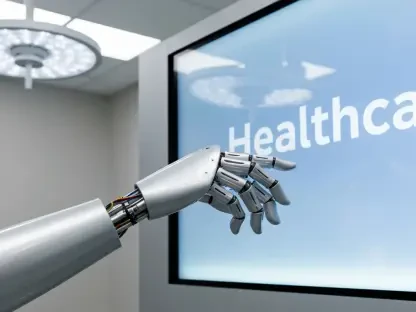In the bustling corridors of a metropolitan hospital, a nurse fumbles with yet another new app on a tablet, struggling to input patient data while a call light blinks urgently nearby, a scene repeated in countless care settings across the nation. This captures a growing frustration among healthcare workers. Despite the promise of digital tools to revolutionize patient care, many providers find themselves drowning in a sea of incompatible systems and impractical solutions. This pervasive exhaustion, known as innovation fatigue, is not just a minor annoyance—it’s a silent crisis threatening the efficiency and morale of an already strained workforce.
The Hidden Cost of Tech Overload
At the heart of this issue lies a stark reality: the healthcare system is buckling under pressure, with staffing shortages and rising patient demands creating a perfect storm. Technology, often heralded as the great equalizer, should be easing these burdens by automating tasks and improving outcomes. Yet, the constant rollout of new tools—many of which fail to integrate with existing systems—has left workers skeptical. The significance of this fatigue cannot be overstated, as it directly impacts the quality of care delivered to millions, with medication errors alone costing an estimated $42 billion annually due to poor coordination.
The emotional toll is equally alarming. Nurses and physicians, already stretched thin, spend hours wrestling with clunky interfaces instead of focusing on patients. This misalignment between tech promises and real-world application is eroding trust, turning potential allies into sources of daily frustration for those on the front lines.
Roots of Disillusionment in Digital Health
Delving deeper, the origins of this weariness become clear through several systemic failures in tech development. Many digital solutions are crafted in isolation, ignoring the fragmented, often analog nature of healthcare delivery, especially in rural clinics where paper records still dominate. Developers frequently assume a level of infrastructure that simply doesn’t exist in many settings, rendering their tools useless to a significant portion of providers.
Another sticking point is the industry’s fixation on cutting-edge advancements like artificial intelligence, while basic needs go unmet. For instance, ensuring a patient has reliable transportation to a follow-up appointment often takes precedence over predictive analytics, yet such practical concerns are rarely addressed by new platforms. This disconnect highlights a fundamental flaw in prioritizing flash over function.
Lastly, the voices of frontline staff—independent physicians, behavioral health providers, and nurses—are often sidelined in favor of impressing hospital administrators. The result is a slew of tools that add to workloads rather than reducing them, deepening the sense of alienation among those who use them daily.
Stories from the Trenches
Echoing these challenges, a seasoned healthcare executive notes, “Workers aren’t against progress; they’re against tools that don’t match their reality.” This sentiment resonates across the industry, from urban hospitals to remote facilities where reliable internet remains a luxury. Rural providers, in particular, recount the absurdity of being pitched sophisticated data platforms when basic connectivity is still out of reach.
Supporting these anecdotes, research paints a grim picture of the fallout. Studies indicate that poorly designed technology contributes significantly to burnout, with medical staff spending up to 40% of their time on administrative tasks that could be streamlined with intuitive systems. These numbers underscore a critical mismatch between intention and impact in healthcare innovation.
In one striking example, a nurse in a small community clinic described the frustration of toggling between three separate apps to update a single patient’s chart, only to find the data didn’t sync across platforms. Such experiences are not outliers but rather emblematic of a broader struggle, where the promise of efficiency becomes a daily hurdle.
Consequences for Care and Morale
The ripple effects of innovation fatigue extend far beyond mere annoyance, striking at the core of patient safety and provider well-being. When healthcare workers reject new tools out of sheer exhaustion, they often revert to outdated methods like fax machines, leading to communication breakdowns that jeopardize care coordination. This resistance isn’t born of stubbornness but of repeated disappointment with systems that fail to deliver.
Moreover, the mental strain of navigating disjointed technologies compounds the already high stress levels in the field. With burnout rates among nurses climbing—recent surveys show over 50% considering leaving the profession—ignoring this issue risks further depleting an essential workforce. The stakes are high, as every misstep in tech adoption can translate to errors in treatment or delays in critical interventions.
Patient outcomes bear the brunt of these challenges as well. Fragmented systems mean vital information often slips through the cracks, whether it’s a missed medication update or a lost referral. Addressing this fatigue isn’t just about improving workflows; it’s about safeguarding the trust and health of entire communities reliant on these providers.
Pathways to Restoring Faith in Technology
Reversing this trend demands a radical rethink of how innovation is approached in healthcare. Developers must embed themselves in diverse care environments, from bustling emergency rooms to under-resourced skilled nursing facilities, to grasp the true constraints and workflows of staff. Only through such immersion can solutions be tailored to fit the gritty realities of the field.
Equally critical is a pivot toward practical tools that tackle everyday coordination challenges before chasing high-tech novelties. Platforms that ensure seamless follow-up tracking or update patient contact details across systems could save hours of manual effort, offering immediate relief to overworked teams. Interoperability, too, must be a cornerstone, bridging the gap between modern electronic records and the outdated methods still in use.
Finally, healthcare leaders should push for pilot programs in underserved areas, testing innovations in settings often overlooked by tech giants. By proving scalability and relevance in rural clinics or post-acute care, the industry can rebuild confidence in technology as a genuine partner. This collaborative, grounded approach holds the key to transforming skepticism into renewed hope.
Reflecting on a Way Forward
Looking back, the struggle with innovation fatigue revealed a profound disconnect between the aspirations of digital health and the lived experiences of healthcare workers. The stories of frustration, paired with staggering data on burnout and errors, painted a sobering picture of an industry at odds with its own tools. Yet, within those challenges lay seeds of opportunity for meaningful change.
Moving ahead, the focus must shift to actionable steps that prioritize the human element of care delivery. Stakeholders across the spectrum—developers, administrators, and policymakers—need to commit to designing solutions that truly serve frontline staff, addressing mundane yet vital needs like care coordination. By fostering this alignment over the coming years, from 2025 onward, the healthcare sector can turn the tide, ensuring technology becomes a trusted ally rather than a persistent burden.









